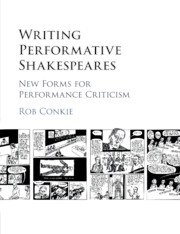Introduction
Published online by Cambridge University Press: 05 March 2016
Summary
Writing performative Shakespeares
When the project that has become Writing Performative Shakespeares was just beginning, some time before it knew or had named itself, the (writing) practice definitely preceded its theorisation. Therefore, this introduction – which will attempt to explicate what is here meant by that slippery and ubiquitous term performative, what is here practised as performative writing, and what is here defined and theorised as writing performative Shakespeares – will be, to some extent at least, retrospective and revisionist. What turned out to be this first instance of writing performative Shakespeares, a revision of which features as Chapter 2 of this book, came about because of my incapacity to provide a linear account of (Shakespearean) theatrical meaning-making as contingent upon each of its various materialities, discourses and practices. Thus, in attempting to analyse a production of Othello that I had directed, and being unable to represent (in linear form) its discursive effects as a productive coalescence of, for example, the text used, the rehearsal processes, its various contexts, theoretical, cultural, historical and pedagogical, the finished production itself and its reception, I eventually opted to allocate equal and post-structured space to each of those elements via the form of a Sudoku puzzle. In order to publish that article I was required to frame it with an introduction – which began with an exhortation to skip straight to the puzzle – which was also a retrospective theorisation of writing practice subsequently labelled performative.
Why then, apart from attending to explanations of this book's specific understandings and deployments of performative writing, continue reading this introduction, and not go straight to the collection of puzzles, creative and innovative forms – the writing of performative Shakespeares – that follows? It is certainly possible, of course, to consider any of the following case study chapters without having read this overall introduction, each of which is framed by its own contextual and, to some extent, discrete (and, in some cases, retrospective) introduction. On the other hand, the chapters are ordered in such a way as to offer a developing argument – which is outlined below – about types of written performative engagement with Shakespearean production, each designed to inter vene in methodological debates about Shakespeare in performance criticism.
- Type
- Chapter
- Information
- Writing Performative ShakespearesNew Forms for Performance Criticism, pp. 1 - 24Publisher: Cambridge University PressPrint publication year: 2016

